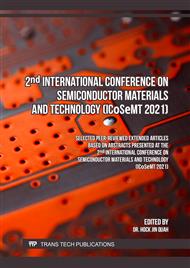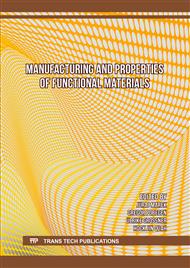p.47
p.53
p.61
p.67
p.75
p.81
p.89
p.97
p.103
Thermomechanical and Dielectric Properties Relationship of Hybrid Carbon Black and Nano Silica Epoxy Composites
Abstract:
Multifunctional materials refer to the types of materials that possess enhanced mechanical, electrical, and thermal properties. In this work, nano silica and Carbon Black (CB) are added to epoxy polymer as an effort to improve the thermomechanical and dielectric properties of the composites. Filler loadings are varied from 0.1 wt.%, up till 5 wt.%. The thermomechanical properties are measured from Dynamic Mechanical Thermal Analysis (DMTA) while the dielectric properties are measured from Vector Network Analyser (VNA). The synergistic effects of combining both fillers (keeping them at 1:1 wt.% ratio) are also assessed. It was found that the value of glass transition temperature (Tg) increased from 56.85°C (neat epoxy) to 59.8°C (5 wt.% CB). The Tq values further increased to 64.7°C, for 5 wt.% hybrid fillers (2.5 wt.% silica + 2.5 wt.% CB), demonstrating the synergistic effects by employing dual fillers. By adding single and dual fillers, the values of storage Modulus, E’ remains almost constant for both glassy (40°C) and rubbery region (100°C), regardless of the loadings employed. The values of real permittivity, er’ was also measured for dual fillers in the frequency range between 300 kHz to 18 GHz. The highest value of er’ was 5.5 F/m, which was measured for both 1.5 mm and 2.0 mm sample thickness of 5 wt.% hybrid fillers (2.5 wt.% silica + 2.5 wt.% CB). This study highlights the thermomechanical and dielectric properties improvement of epoxy composites by incorporating dual fillers.
Info:
Periodical:
Pages:
75-80
Citation:
Online since:
June 2023
Price:
Сopyright:
© 2023 Trans Tech Publications Ltd. All Rights Reserved
Share:
Citation:



